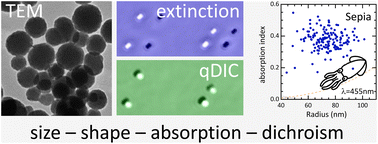Optical absorption and dichroism of single melanin nanoparticles†
Abstract
Melanin nanoparticles (NPs) have important biological functions including photoprotection and colouration, and artificial melanin-like NPs are relevant for catalysis, drug delivery, diagnosis and therapy. Despite their importance, the optical properties of single melanin NPs have not been measured. We combine quantitative differential interference contrast (qDIC) and extinction microscopy to characterise the optical properties of single NPs, both naturally sourced from cuttlefish ink, as well as synthetic NPs using polydopamine (PDA) and L-3,4-dihydroxyphenylalanine (L-DOPA). Combining qDIC with extinction, we determine the absorption index of individual NPs. We find that on average the natural melanin NPs have a higher absorption index than the artificial melanin NPs. From the analysis of the polarisation-dependent NP extinction, the NP aspect ratio is determined, with mean values at 405 nm wavelength in agreement with transmission electron microscopy. At longer wavelengths, we observe an additional optical anisotropy which is attributed to dichroism by structural ordering of the melanin. Our quantitative analysis yields a dichroism of 2–10% of the absorption index, increasing with wavelength from 455 nm to 660 nm for L-DOPA and PDA. Such an in-depth quantification of the optical properties of single melanin NPs is important for the design and future application of these ubiquitous bionanomaterials.



 Please wait while we load your content...
Please wait while we load your content...